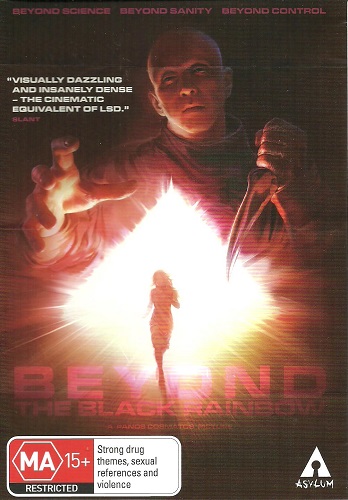Beyond the Black Rainbow (2010) |
|
Beyond the Black Rainbow (2010) |
|


|
| BUY IT |
| General | Extras | ||
| Category | Horror/Sci-Fi |
Theatrical Trailer-(2:08) 2.35:1 and 16x9 in quality comparable to the feature. Theatrical Trailer-Liquid (1:40) : 2.35:1 and 16x9 Theatrical Trailer-Monsters (1:47) : 2.35:1 and 16x9 Theatrical Trailer-Hell (1:52) : 2.35:1 and 16x9. Theatrical Trailer-Troll Hunter (1:22) : 1.78:1 and 16x9. Theatrical Trailer-Sauna (1:27) : 2.35:1 and 16x9. Theatrical Trailer-Lake Mungo (1:51) : 1.78:1 and 16x9 |
|
| Rating |

|
||
| Year Of Production | 2010 | ||
| Running Time | 105:09 (Case: 110) | ||
| RSDL / Flipper | No/No | Cast & Crew | |
| Start Up | Menu | ||
| Region Coding | 4 | Directed By | Panos Cosmatos |
|
Studio
Distributor |
Magnet Madman Entertainment |
Starring |
Michael Rogers Eva Allan Scott Hylands Rondel Reynoldson Marilyn Norry Gerry South Chris Gauthier Sara Stockstad |
| Case | Amaray-Opaque | ||
| RPI | $29.95 | Music | Jeremy Schmidt |
| Video | Audio | ||
| Pan & Scan/Full Frame | None |
English Dolby Digital 5.1 (448Kb/s) English dts 5.1 (448Kb/s) |
|
| Widescreen Aspect Ratio | 2.35:1 | ||
| 16x9 Enhancement |
 |
||
| Video Format | 576i (PAL) | ||
| Original Aspect Ratio | 2.30:1 | Miscellaneous | |
| Jacket Pictures | Yes | ||
| Subtitles | None | Smoking | No |
| Annoying Product Placement | No | ||
| Action In or After Credits | Yes, Four minute faux commercial starts film. | ||
Beyond the Black Rainbow is a 2010 Canadian sci-fi film, produced and filmed in Vancouver, and written and directed by Panis Cosmatos in his feature debut. The movie was shown at a few festivals during 2011, including New York's Tribecca, and as a result eventually won itself feature release. Cosmatos is the son of George P. Cosmatos, director of Rambo : First Blood Part II and Cobra, amongst others. The son's feature was in fact financed by TV residuals from his father's 1993 western Tombstone.
Cosmatos is one of the growing line of youthful filmmakers whose greatest influence is the films which were part of his life experience. The cinema's masters of old, Cukor, Wilder, Wyler, Kubrik, Chaplin et al, were influenced by other disciplines such as art, music, literature and life itself. Possibly beginning with Stephen Spielberg - but I stand to be corrected - we have directors who are primarily influenced by the achievements of other directors. This inward gazing has reduced the artistic merit of films, at least in my view. Nevertheless, young Mr Cosmatos pays considerable tribute to some past great cinematic art, while creating something which on its own merit is at least visually arresting and provocative.
The film opens, pre credits, with a square screen TV promotion for something called The Arborial Institute. This four minute commercial is delivered by Dr Mercurio Arboria (Scott Hylands of TV's V), founder of the institute. The good doctor extols the virtues of the establishment, which sounds like some sort of rehabilitation centre which aims at improving the individual's "state of mind" while helping the patient find a new and improved "way of being". At the conclusion of the TV spiel - exactly four minutes into the film's running time - we go to the film's full widescreen credits. The Institute was established in the 1960s by Dr Arboria in an attempt to reconcile science and spirituality, a reconciliation that would lead humans into a new age of perpetual happiness. We move into the 1980s and Arboria's work has been taken over by a protege of Arboria's, Dr Barry Nyle (Michael Rogers), a handsome, outwardly charming man who is actually a psychopath. Nyle has held a teenage girl, Elena (Eva Allan), captive in an elaborate prison cum hospital concealed beneath The Institute. Elena has some sort of telekinetic power, and Dr Nyle spends much time questioning her from behind a glass panel, tapping his pen while she utters not a word - until about thirty minutes into the film. It is all very weird, at times confusing and baffling. Nyle goes home to a woman, but is it his wife or his mother? Through the questioning between doctor and patient the mystery of the institute and the crazed doctor are unravelled. In the process there is a murder, an exploding head, giants in space suits, submersion into an inky vat, drug overdoses, a zombie-like creature, slasher deaths and a room full of "sentionauts", sexless beings with the faces of baby dolls. And there is more!
Visually the film is arresting, in a pop art, music video style. The cinematography of Norm Li (In Their Skin) creates visual art from the angular planes, glass panels, reflective surfaces and blank monochromatic backdrops of the set design. There is also a black and white flashback sequence which is one of the most effective sections of the film. Much of the time we are reminded of the look of Kubrick's 2001 : A Space Odyssey, or A Clockwork Orange. But there is only the superficial look of those films, nothing deeper. The soul of this film is about as empty as the screen is frequently blank. Adding to the considerable visual style we have an excellent synthesised soundtrack, composed by Jeremy Schmidt and spreads impressively around the complete soundfield.
It is difficult to enjoy a film that is confusing, if not baffling, for much of its running time. I can see that many devotees of cult cinema and things psychedelic will embrace this and make it a cult classic. I'm afraid that for me it was a confusing, beautifully designed exercise created to satisfy the director's personal nostalgia.
Beyond the Black Rainbow is not a film that can be judged technically by normal standards. The director obviously had the intention to give the film an old, worn look, and the transfer delivers what I would say was exactly what the filmmaker intended.
The film is presented at the original aspect ratio of 2.35:1, and the image is 16x9 enhanced.
There has been an extensive use of processing in the filming of this movie, both pre and post. The opening TV promotion for The Institute is made to look like an old Super 8 movie, with some minor damage and heavily grained image. Once we are into the film proper the grain is still evident, derived from filming with a modified Panavision 35mm camera. We even see the occasional white fleck or scratch evident - all part of the intended look of the film. The film looks as though it was made in the 80s, even employing intentional bleeding of the chemically altered colours. The colour palette is heavily stylized, with the revved up reds and blues frequently dominant. There are, however, moments of great fidelity, particularly in close ups of faces and inanimate objects. These are contrasted with the soft focus backgrounds, and the occasionally intentionally out-of-focus shot. Despite all of this manipulation the image is dramatically impressive, with no compression artefacts or noise reduction issues.
The layer change is marked by a momentary freeze of the image (61:52).
Although the slick states that there are English subtitles, there were no subtitles on my copy of the film.
| Sharpness | |
| Shadow Detail | |
| Colour | |
| Grain/Pixelization | |
| Film-To-Video Artefacts | |
| Film Artefacts | |
| Overall |
There are two audio streams, English Dolby Digital 5.1 and English DTS 5.1.
The soundtrack is very impressive, adding considerably to the impact of the film.
The minimal dialogue is front and centre and is clear and clean, though a little flat which is probably intentional. It is never swamped by the considerable aural competition and there are no sync problems. The world of The Institute is almost tomb like and there is little opportunity for activity in the surrounds. Immersion in the aural experience comes from the occasional alarms, chimes and dings which come from the austere environment, but primarily from the outstanding synthesized score by Jeremy Schmidt. This score, with its drones, electronic beeps and thumps, surrounds us, and at times pans spectacularly around the soundscape. The myriad of electronic sounds is delivered with great clarity and considerable bass oomph. This strong low-end at times rattles the walls and floorboards.
| Dialogue | |
| Audio Sync | |
| Clicks/Pops/Dropouts | |
| Surround Channel Use | |
| Subwoofer | |
| Overall |
As with the Region 1 release, there is a disappointing absence of extras.
The menu reproduces the still from the slick with a section of the synthesized score. There is no animation.
The trailer is comparable in quality to the feature. Presented 2.35:1 and 16x9 enhanced, with Dolby Digital 2.0 Surround Encoded audio.
Six trailers, all of very good quality :
There is censorship information available for this title. Click here to read it (a new window will open). WARNING: Often these entries contain MAJOR plot spoilers.
NOTE: To view non-R4 releases, your equipment needs to be multi-zone compatible and usually also NTSC compatible.
Beyond the Black Rainbow is not a successful film because it flatly does not entertain. It is far too confusing with a plot that barely exists. As a substitute for substance we get a series of bizarre images, and that's simply not enough. On such a low budget, visually it is quite an achievement, and the soundtrack deserves a much better film. If you sit down in the right mood, with a drink or two and some convivial company, you might have a good time. But only then. No extras.
| Video | |
| Audio | |
| Extras | |
| Plot | |
| Overall |
| Review Equipment | |
| DVD | SONY BLU RAY BDP-S350, using HDMI output |
| Display | Samsung LA55A950D1F : 55 inch LCD HD. Calibrated with THX Optimizer. This display device is 16x9 capable. This display device has a maximum native resolution of 1080p. |
| Audio Decoder | Built in to DVD player. Calibrated with THX Optimizer. |
| Amplification | Onkyo TX-DS777 |
| Speakers | VAF DC-X fronts; VAF DC-6 center; VAF DC-2 rears; LFE-07subwoofer (80W X 2) |